Hanna-Barbera (1985), Warner Home Video (October 23, 2007), 2 discs, 170 mins plus supplements, 1.33:1 original full frame ratio, Dolby Digital 1.0 Mono, Not Rated, Retail: $26.98
Storyboard:
The Super Friends gain a new name and a new member in the bionic teen called Cyborg. Darkseid continues to plot galactic domination, and numerous other classic villains show up to challenge the team.

The Sweatbox Review:
Almost every season, the Super Friends show seemed to evolve. The 1984 version, subtitled The Legendary Super Powers Show, had unprecedented influence from a toy manufacturer that led to adding a teenage hero named Firestorm as well as the cosmic villain Darkseid to the show. This evolution would continue in 1985, when “Super Friends” was finally dropped from the title altogether and the show became directly named for the Kenner toy line that sponsored its transformation. DC Comics’ “Justice League Of America” was henceforth to be known on television as “The Super Powers Team,” even though they still carried communicators with the initials “JLA” on them. Furthermore, another new member was added, Cyborg, who appeared in the popular New Teen Titans comic book series.
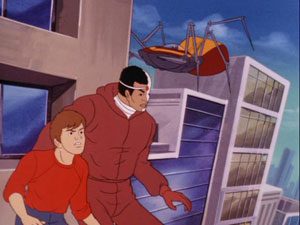
The look of the show was also updated for this season. After many years, the Alex Toth designs were cast aside in favor of using Jose Luis Garcia Lopez’s designs from the DC Comics style guide. The more contemporary look was a great idea… in theory. While the characters generally looked great in the show’s opening sequence, once the episode began it became painfully obvious that the artists available could not draw like Jose Luis Garcia Lopez any more than they could draw like Alex Toth. Depending on the scene, the characters could look half-decent, or they could look like a first-year art student’s attempt at copying someone else’s drawing; that is to say, not so good. Awkward figures, with overly-detailed but bad anatomy, make it painfully obvious that Bruce Timm had the right idea when he simplified his designs years later for Batman: the Animated Series, a show that always managed to look cool even when animated by less-talented subcontracted studios. Nevertheless, the new designs were a breath of fresh air after seeing poor Toth’s work mangled for so many years. Aquaman maybe benefited the most, looking much more rugged with messy hair rather than the dated wavy hair he had worn since the early 70s. (Although, the wavy-haired Aquaman appears on the cover for this release. The Warner Home Video art department can’t ever get these things right, it seems.) Wonder Woman also looks less cartoon-ish, but Superman’s appearance seems most prone to changing from shot to shot.
The Wonder Twins are absent from this version, which will make some happy and others regretful, as the focus stays on core members Superman, Batman (sometimes with Robin), and Wonder Woman, as well as the newer members Firestorm and Cyborg. We still get glimpses here of a few other Justice Leaguers, though, with Flash, Green Lantern, and Aquaman each getting their moment in the sun. Samurai and El Dorado are the only holdovers among the “ethnic heroes” of previous seasons, making brief appearances. This season carried eight episodes, with most carrying full-length stories and two episodes having two stories each.
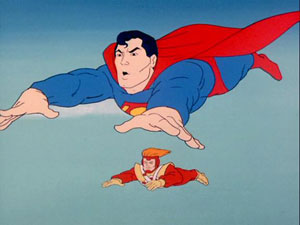
Disc One
The Seeds Of Doom introduces Cyborg to the team. He is initially reluctant to join after assisting in the capture of Lex Luthor, but even he has to admit how useful he is to the Super Powers Team as they defeat Darkseid’s plan to transform the Earth into an Apokolips type of planet using thousands of “seeds.” I was thrilled to see Firestorm’s “fire hair” finally animated properly in this episode, but unfortunately this does not last throughout this run of episodes. More consistent is the new use of shading, especially used to good effect in making Cyborg’s prosthetics appear metallic.
Ghost Ship is a shorter story which sees Superman, Firestorm, and Cyborg encounter an apparent derelict that has a single inhabitant, who holds her entire society in a locket around her neck. As the Team was being pursued by Darkseid at the time, they must prevent Darkseid from taking advantage of the situation. The Bizarro Super Powers Team, the second story in this episode, has two supervillains. Obviously, Bizarro appears, travelling from the Bizarro World to make duplicates of the Super Powers Team to bring home with him. He successfully duplicates Wonder Woman, Firestorm, and Cyborg, which might have been fine except that Mr. Mxyzptlk also gets involved, creating almost more mischief than the team can handle.

The Darkseid Deception is one of the stronger episodes, bringing Wonder Woman’s boyfriend Steve Trevor onto the show. Steve is captured by Darkseid and replaced in order for Darkseid to capture control of a satellite.
The Fear was originally conceived as a pilot for a Batman cartoon show, and it includes the first time that Batman’s origin was shown in any medium other than comic books. Incredibly, you may not even notice on first viewing that they manage to convey Batman’s origin without ever showing a gun or hearing a gunshot, which was necessary due to the restrictions of Saturday morning programming in 1985. The origin is shown in flashback, explaining why Batman is paralysed when he enters Crime Alley in pursuit of The Scarecrow. Robin and Wonder Woman are also featured in this one, and this is the ONE time in the long history of Super Friends shows that we see Batman and Robin in their civilian identities!
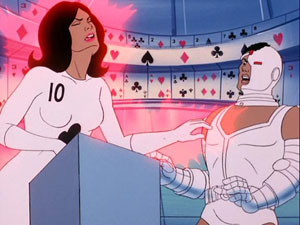
Disc Two
The Wild Cards sees the formation of The Royal Flush Gang, with not one but two major sponsors. Darkseid’s influence is clear, but Batman also realizes that there is one card from this deck not yet accounted for. It’s hard to believe, but this particular clownish character NEVER appeared on any other Super Friends episode.
Brainchild brings back the early/mid-1980s version of Brainiac, who takes over Cyborg in his effort to defeat the team. The second half of this episode is The Case Of The Stolen Super Powers, which is a fun one that could easily have been expanded into a longer story. Felix Faust steals Superman’s powers, but his cellmate The Penguin intercepts them and goes on a super-powered crime spree. Faust and Pengy make their only Super Friends appearances here.
Escape From Space City has an orbiting satellite, actually called “Star City” in the episode, taken over by Darkseid as part of a massive invasion plan. While part of the team follows up on a distress call from Star City, Aquaman investigates Darkseid’s island base near Paradise Island.
The Death Of Superman vaguely ties into the famous “imaginary story” written by Jerry Siegel in 1961, though it also has interesting similarities to the 1990s Death Of Superman comics storyline. Superman apparently has turned green and died as a result of Kryptonite poisoning, as Metropolis and the Super Powers Team mourn while wearing black armbands with the Superman “S” shield. Firestorm seems to feel responsible, so Darkseid kidnaps him to learn the full story. Meanwhile, some of the Team travels to Superman’s Fortress of Solitude to put his things in order. Darkseid attempts to take full advantage of the situation, and launches his biggest attack on earth yet.
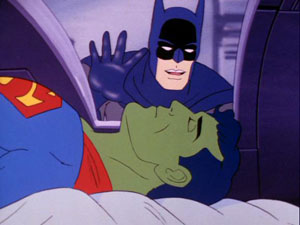
Although this version of Super Friends still doesn’t reach the level of sophistication that would be seen in the DC shows of the 1990s and 2000s, it is clearly a step in the right direction. The storylines are certainly less goofy, and the animation mistakes become less frequent in this series, with a good mix of plotlines and characters. It’s too bad that only Firestorm and Cyborg have any semblance of a personality, but it beats having every member of the team being a cardboard cutout. If you found previous seasons hard to get through, you just might make it through this one, but certainly the height of the Justice League’s television career remains the more recent Bruce Timm-produced series.
Is This Thing Loaded?
In the Super Friends Redux: Galactic Guardians retrospective featurette (11:09), a variety of relevant commentators discuss the show’s place in the history of DC cartoons. Comics writer Mark Waid, Galactic Guardians writer Rich Fogel, and current DC bigwig Dan Didio discuss how this series brought the Super Friends more in line with DC’s monthly publications. DC publisher Paul Levitz talks about how Kenner Toys’ marketing needs influenced the show, series writer Alan Burnett adds some good points, and storyboard artist Michael Swanigan touches on Cyborg’s status as the audience’s entry point. The importance of The Dark and The Death Of Superman is also discussed.
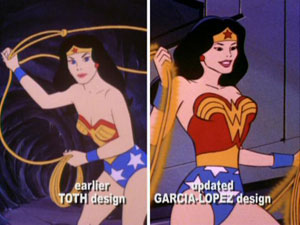
Trailers for Looney Tunes, Smurfs and Tom And Jerry round things out.
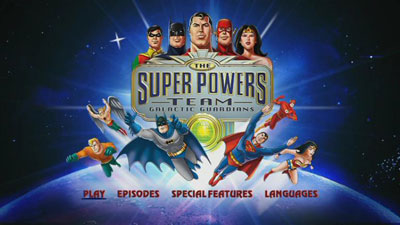
Case Study:
The ultra-slim digipack is comfortably seated inside a slipcover with the same image on the front. The rest of the digipack has attractive original artwork. Both discs, in an overlapping disc configuration, are single-sided with unique disc art. The cover incorrectly states that this set has ten episodes, but then Warner Home Video seems to have trouble with the definition of “episode” on many of their sets. As I stated above, this set actually has eight episodes, with a total of ten stories.
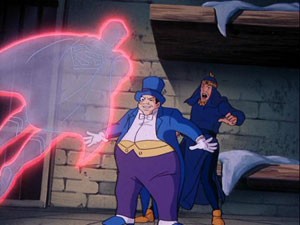
Ink And Paint:
This is likely the best that the Super Friends have looked on DVD. There is barely a hint of shimmer here, and though the prints are not totally clean (containing a modest amount of dust and smudges), they are given strong transfers. Of course, with only four episodes per disc, one would expect minimal problems, and fortunately the DVDs deliver. Still, the materials are two decades old, so there is a softness present that one would not see on a more recent TV cartoon compilation.
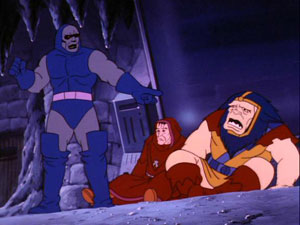
Scratch Tracks:
The mono sound here is typical of what one could expect, offering clear sound reproduction without doing much to impress. English is the only option available, with English subtitles for the hearing impaired also present for those that require them.

Final Cut:
The Super Friends end their long television run on a relatively high note. The seeds of the future are present, with more cosmic storylines and higher stakes, yet still within the context of a Saturday morning show clearly done for kids. The video and audio are the best we’ve seen for these releases, and the featurette, though short, nicely places the show in context even if it does less than the featurettes on the previous Super Friends release. If you have been collecting all the DVD releases for the Super Friends, this is a must own. The only direction to go now is backwards, as we look forward to Warner releasing earlier seasons of Super Friends. So, if you are lamenting the end of this show, worry not— there are still plenty of older episodes yet to be released; and so long as you keep buying them, I’m sure Warner will be happy to keep releasing them.
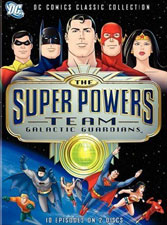 | ||
 |







